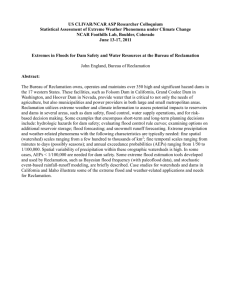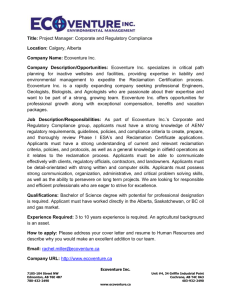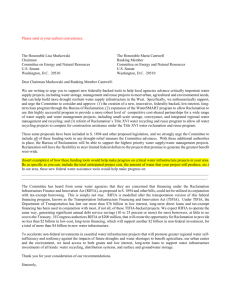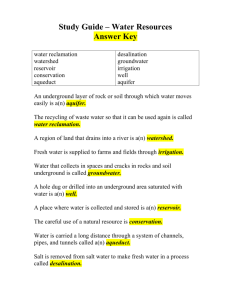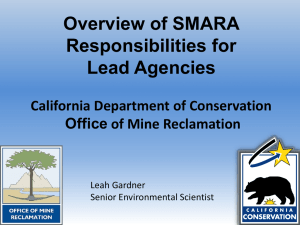1 HOOVER DAM MODERNIZATION PROJECT FIRST OF ITS KIND
advertisement
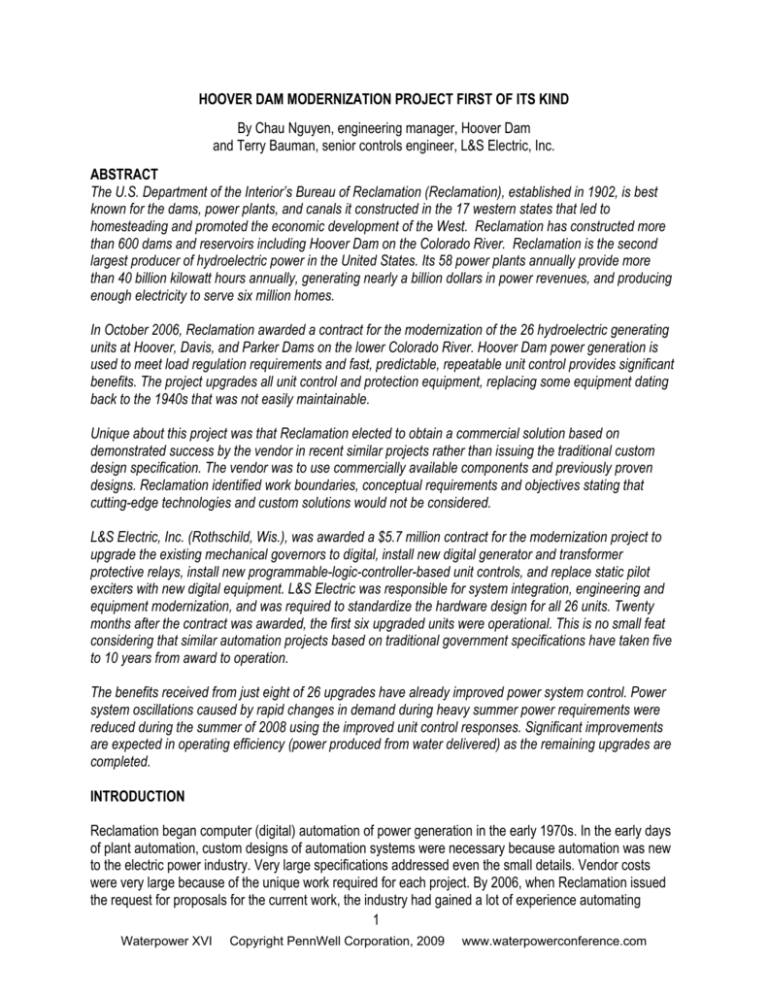
HOOVER DAM MODERNIZATION PROJECT FIRST OF ITS KIND By Chau Nguyen, engineering manager, Hoover Dam and Terry Bauman, senior controls engineer, L&S Electric, Inc. ABSTRACT The U.S. Department of the Interior’s Bureau of Reclamation (Reclamation), established in 1902, is best known for the dams, power plants, and canals it constructed in the 17 western states that led to homesteading and promoted the economic development of the West. Reclamation has constructed more than 600 dams and reservoirs including Hoover Dam on the Colorado River. Reclamation is the second largest producer of hydroelectric power in the United States. Its 58 power plants annually provide more than 40 billion kilowatt hours annually, generating nearly a billion dollars in power revenues, and producing enough electricity to serve six million homes. In October 2006, Reclamation awarded a contract for the modernization of the 26 hydroelectric generating units at Hoover, Davis, and Parker Dams on the lower Colorado River. Hoover Dam power generation is used to meet load regulation requirements and fast, predictable, repeatable unit control provides significant benefits. The project upgrades all unit control and protection equipment, replacing some equipment dating back to the 1940s that was not easily maintainable. Unique about this project was that Reclamation elected to obtain a commercial solution based on demonstrated success by the vendor in recent similar projects rather than issuing the traditional custom design specification. The vendor was to use commercially available components and previously proven designs. Reclamation identified work boundaries, conceptual requirements and objectives stating that cutting-edge technologies and custom solutions would not be considered. L&S Electric, Inc. (Rothschild, Wis.), was awarded a $5.7 million contract for the modernization project to upgrade the existing mechanical governors to digital, install new digital generator and transformer protective relays, install new programmable-logic-controller-based unit controls, and replace static pilot exciters with new digital equipment. L&S Electric was responsible for system integration, engineering and equipment modernization, and was required to standardize the hardware design for all 26 units. Twenty months after the contract was awarded, the first six upgraded units were operational. This is no small feat considering that similar automation projects based on traditional government specifications have taken five to 10 years from award to operation. The benefits received from just eight of 26 upgrades have already improved power system control. Power system oscillations caused by rapid changes in demand during heavy summer power requirements were reduced during the summer of 2008 using the improved unit control responses. Significant improvements are expected in operating efficiency (power produced from water delivered) as the remaining upgrades are completed. INTRODUCTION Reclamation began computer (digital) automation of power generation in the early 1970s. In the early days of plant automation, custom designs of automation systems were necessary because automation was new to the electric power industry. Very large specifications addressed even the small details. Vendor costs were very large because of the unique work required for each project. By 2006, when Reclamation issued the request for proposals for the current work, the industry had gained a lot of experience automating 1 Waterpower XVI Copyright PennWell Corporation, 2009 www.waterpowerconference.com electric power plants. However, many suppliers of power-generation automation equipment continued to produce complex custom automation systems that take years to design, implement, install and test. These suppliers, structured in the 1970s to produce customized systems, continued to rely on the market for engineering intensive projects to support their costly infrastructure. Reclamation had many experiences with these lengthy, costly automation upgrades. Reclamation works closely with water and power customers who fund the maintenance and improvements at Hoover Dam to address operation and maintenance issues and to define the scope of improvement projects. As project planning started in 2004, the power customers needed a more cost effective approach for the modernization project that would mesh with rigorous time schedules. Historically, rapid evolution of computer equipment made it necessary to replace computer automation hardware and software frequently. The priority on system security since 9/11 increased the number of required computer changes. It was often necessary to defer the costs of upgrades to plant systems in order to fund changes to the computer systems. The result has been aging of generator hardware including governors, excitation systems, protection systems, and the control boards that were the traditional operator interface for unit control. A primary objective of Reclamation and its power customers for this project was reliable, predictable load and voltage control. A new upgrade of computer hardware and software interfaced to outdated governor speed adjust motors in aging mechanical governors would not be an acceptable solution. Similarly, new computer control interface to vintage voltage adjust motors in the analog voltage regulators would also be unacceptable. INTEGRATING FOUR SYSTEMS During the planning process, Reclamation personnel visited hydro facilities. They interviewed plant automation managers, operators and maintenance personnel. The best solutions reported replaced all four subsystems — governors, protection, excitation and control boards — at once. Replacing subsystems one at a time would require an outage for each. Completing the work in one outage rather than multiple outages is a definite advantage in many ways. Replacing all four subsystems at the same time requires only one system integration and one revision of plant control. Requiring a system integrator to interface to existing subsystems introduces significant unknown risks and drives up vendor costs. Replacing all four subsystems meant the vendor was integrating only equipment supplied by the vendor. Reclamation took actions to reduce risk to schedules and costs. It limited the scope of the contract to unit modernization, limited the scope of the contract to engineering and equipment supply and limited the duration of the equipment supply contract to three years. These actions underscored Reclamation’s priorities on schedule and cost. The actions also emphasized Reclamation’s role in installation and commissioning for several years after the vendor completed equipment production and delivery. The vendor participated in commissioning for only the first eight of the twenty-six units included in the project. Reclamation is upgrading six units each year. There are three outages each year and two units are modernized during each outage. Each outage lasts five to six weeks. 2 Waterpower XVI Copyright PennWell Corporation, 2009 www.waterpowerconference.com UNCHARTERED TERRITORY Hoover Dam is a marvel of American engineering ingenuity. Reclamation committed to doing something ingenious in modernizing operation of Hoover, Davis and Parker power generation. Reclamation and its power customers defined several plant modernization objectives: Short duration with rigid attention to water and power delivery schedules Upgrade unit control subsystems, not just the plant control automation system Simple preferred to complex Standardize the equipment and operation for all 26 generating units in the three dams Security to be inherent in the system design Completing the project as quickly as possible reduces risk to customer budget management and increases the probability that those who begin the effort are still involved at the end of the project. Reclamation and its power customers determined that the project must be completed first at Hoover Dam in four years followed by completion at Davis and Parker dams in two more years. Time from award to delivery of equipment for the first two units had to be less than one year to meet the schedule. Upgrading the subsystems to use current digital technology provides benefits: fast, predictable operation; simplified interface between unit and plant control; reduction in hardwired interconnections; elimination of the need for an interface device (such as the previous remote terminal unit or RTU); etc. Simplification, standardization and inherent security are very valuable. They shorten the design time, the manufacturing time, the time to train operators, and the time to train maintenance staff. They make the next upgrade iteration of automation and/or plant systems easier. The standardization of designs for this project included the use of identical equipment cabinets, with identical hardware and wiring termination layout, for modernization work on each of 26 units at Hoover, Davis, and Parker Dams. The standardization was challenging since these units were designed by multiple manufacturers using a variety of turbine, generator, and transformer designs. At Hoover alone, there are six different turbine designs and several different generator designs. The prototype set of cabinets for the first unit was duplicated 25 times. Each set of cabinets was equipped with sufficient input, output, and processing devices to accommodate all units to be modernized. It is common in the power industry to obtain a turnkey solution that replaces plant control and unit control (with or without plant hardware replacement). The pain and cost of such a solution can be enormous. Such projects often run behind schedule and over budget. For Hoover, Davis and Parker Dams, Reclamation and its power customers considered a turnkey solution but opted for the less intrusive and less expensive modular system alternative. Repeating the traditional custom specification process posed too many risks to the objectives, especially to schedule and cost constraints. Reclamation chose to obtain a commercial solution based on demonstrated success by the vendor in recent, similar projects — a radical departure from the normal government procurement process for similar systems based on issuing detailed specifications. However, a commercial, off-the-shelf solution also posed risks. Reclamation determined that to minimize these risks: The unit scope had to be well defined and minimized The equipment had to be standard and readily available from multiple suppliers The technology had to be trustworthy 3 Waterpower XVI Copyright PennWell Corporation, 2009 www.waterpowerconference.com Reusing previous engineering was necessary The system architecture had to be simple and readily adaptable The supplier had to have a proven record of success meeting rigid schedules Reclamation assumed responsibility for installation using in-house staff and contracted labor when necessary. This made it possible to limit the scope of the contract to engineering and equipment supply. Thus, the contract duration could be shorter than the installation schedule. Security requirements for plant automation systems were in a state of flux in 2004. The solution commonly identified as a programmable logic controller (PLC) solution was preferred because of inherent security benefits. Reclamation prepared a request for proposals (RFP) that identified work boundaries, conceptual requirements and project objectives. Reclamation conducted a Value Engineering Review of the project and RFP. Reclamation used unusual proposal evaluation criteria. A simplified description of the criteria, in order of priority, follows: Relevant experience: Successful completion three times in the last five years of projects of similar scope at hydro plants with similar sized units Technical capability: A system integrator of commercial subsystems proposing the same commercial products previously integrated successfully Past performance: Interviews with previous clients that completed projects of similar scope for units of similar type and size: successful collaboration on design; success meeting rigid delivery schedules; and flexible, timely handling of scope modifications with reasonable changes in cost COLLABORATIVE DESIGN PROCESS In October 2006, Reclamation awarded a $5.7 million contract for unit control modernization of the 26 hydroelectric generating units at Hoover, Davis, and Parker Dams to L&S Electric, Inc. L&S Electric was responsible for equipment selection, engineering, system integration, commissioning and training. They manufactured the digital governor and the replacement for the unit control board. L&S Electric’s experience supplying integrated systems for the hydroelectric power industry (more than 400 installations over the past 20 years) was a key to success. Its ability to reuse experience (designs, engineering and firmware) from previous successful hydroelectric power projects provided a commercial off-the-shelf (COTS) capability essential to delivering three complete sets of equipment eleven months after award. Its relationship with Schneider Electric, a global leader in supplying automation and control components for COTS design projects, was instrumental in obtaining timely equipment deliveries. Reclamation recognized that meeting the schedule dictated by rigid water and power delivery requirements from June through September required a partnership in responsibilities with the vendor. Reclamation was responsible for installation. Reclamation and L&S Electric shared responsibilities for design and commissioning. Reclamation and L&S Electric quickly formed a close partnership that was effective throughout the equipment supply contract for modernization of Hoover Dam. Two weeks after award, the entire L&S Electric design and project management team flew to Nevada to meet with Reclamation’s engineering and operations groups. During the course of a three-day visit, the teams visited all three sites and discussed the 4 Waterpower XVI Copyright PennWell Corporation, 2009 www.waterpowerconference.com goals of the project and strategies for a common hardware and software solution that was viable for all 26 units. A month later, Reclamation’s design team flew to Wisconsin to review the conceptual design and to confer on project details. L&S Electric completed the project design based on the results of this review meeting and flew to Nevada two months later to present the final design including the mechanical and electrical drawings and protection functionality. During the entire process, Reclamation and L&S Electric kept up a steady stream of conversation concerning details required to meet the aggressive schedule. L&S Electric and Reclamation agreed to a maximum three-day turnaround time to exchange needed information. Most issues were resolved on the same day via email and/or conference calls. This agreement required a conscious effort, dedication and hard work by both teams and was a key to delivering hardware eleven months after award. A STANDARDIZED SOLUTION FROM L&S ELECTRIC AND SCHNEIDER ELECTRIC L&S Electric was responsible for delivering 26 identical sets of equipment (hardware and firmware). It was to buy required hardware up front to ensure installation of identical equipment on all 26 units. Contracts of this type often include additional costs because of the risk to the vendor associated with the unknown issues during long-term commitments. Installation, operation and maintenance tasks are completed faster and with less risk when all 26 unit controls have the same design. L&S Electric closely reviewed the drawings and the requirements for all 26 units during the conceptual design. They produced a single, unified design comprised of hardware and software that accommodates all the units at the three sites. The skill with which they collected and assimilated a vast amount of details and produced a conceptual design in one month was paramount to a successful design. L&S Electric’s commercial-off-the-shelf (COTS) approach was essential to meeting the rigid schedule. Reclamation preferred a simple PLC solution to a complex Windows-based solution. L&S Electric’s standard solution includes a control system based on PLC technology. The PLC-based solution proposed by L&S Electric met Reclamation’s need for simplicity, while still being highly powerful and reliable. The development tools provide extensive resources allowing L&S Electric to use established function blocks and large sections of firmware from previous projects. The development tools also support a modular design. As a result, the spare parts inventory is smaller, unit operation is more reliable and the time to repair is shorter. L&S Electric provided system diagnostic tools and alarms. GPS time-synchronized sequence of event logs, which track not only alarms and device state changes, but also operator-initiated actions, aid in both troubleshooting issues with the equipment and gathering information for preventive maintenance. L&S Electric utilized distributed I/O to minimize electrical installation and commissioning efforts and supplied graphic touch screen terminals that integrate seamlessly with the PLC. Touch screens replaced the manual switches on the previous control boards. The response of plant operators, after a period of training and familiarization, has been predominately positive to the new interface for controlling unit operation. More information is available to operators through the touch screen interface than was available previously at the control board. L&S Electric supplied the Modicon® PLC, Unity™ development software, Magelis® graphic touch screen 5 Waterpower XVI Copyright PennWell Corporation, 2009 www.waterpowerconference.com terminals and Advantys™ distributed I/O from Schneider Electric. Reclamation can obtain replacement parts from numerous Schneider Electric distributors. L&S Electric supplied Schweitzer Engineering Laboratories, Inc. (SEL®) digital protection. The new digital protection reduced the number of protective devices while still providing redundant protection. Reclamation elected to retain the existing rotating exciter. L&S Electric replaced it with a Basler® digital pilot exciter. Unit Control Board and Static Pilot Exciter BEFORE Unit Control Board and Static Pilot Exciter AFTER OFFERING MORE IN LESS TIME L&S Electric offers management, design, procurement, manufacturing and testing capabilities, and is a systems integrator as well. Having all of these services under one roof allowed L&S Electric to maintain an aggressive schedule and better control the quality of the solution. L&S Electric completed assembly, wiring and factory checkout of the equipment at L&S Electric’s site where Reclamation witnessed factory acceptance tests. Integrating the equipment at the L&S Electric facility significantly reduced the length of the outages. A key to staying on schedule was the established formal project management structure at L&S Electric. The role of the project administrator was invaluable. CONCLUSIONS Modernization project timeliness and cost effectiveness resulted from: The L&S Electric Unit Control Modernization equipment supply contract Plant installation managed by Reclamation personnel Plant labor supplemented by contracted labor Separation of plant control and unit control modernization tasks The equipment supply contract with L&S Electric is complete for Hoover Dam. Unit control modernization (i.e., installation and commissioning) is complete for 12 of the 17 units at Hoover Dam. The modernization of all 26 units at the three dams in the project scope (Hoover, Davis, and Parker Dams) will be complete in 2012. 6 Waterpower XVI Copyright PennWell Corporation, 2009 www.waterpowerconference.com The Unit Control Modernization project using equipment supplied by L&S Electric is a large part of the modernization of the three dams. Modernization of six of the 26 generating units was complete 20 months after award. The contract produced many improvements associated with modern digital systems. Maintenance is simplified and less maintenance is required. Arizona Power House BEFORE Modernization (Control Boards and Static Pilot Exciters) Arizona Power House AFTER Modernization (Control Boards and Static Pilot Exciters) The speed, predictability and repeatability of the unit control are improved. Hoover Dam power generation provides load regulation and fast, predictable, repeatable unit control provides significant benefits. For example, prior to the unit control modernization the rate of loading for large load changes varied from 15 to 30 MW per minute and now the rate is a repeatable 80 MW per minute. Improvements made it possible to reduce power system oscillations caused by rapid changes in demand during heavy summer power requirements. Control Boards and Static Pilot Exciter BEFORE Modernization Control Boards and Static Pilot Exciter AFTER Modernization In addition, changing the unit from a synchronous condensing (or motoring) state to a generating state previously required up to 2 minutes. Now this state change takes 30 seconds or less. Significant improvements in operating efficiency (i.e., power produced from water delivered) are possible because of the improvements. 7 Waterpower XVI Copyright PennWell Corporation, 2009 www.waterpowerconference.com Governor BEFORE Modernization Governor AFTER Modernization The modernization of operation of three dams authorized and funded by Reclamation’s power customers includes more than the Unit Control Modernization contract awarded to L&S Electric. Reclamation modernized plant control using in-house resources. Excluding plant control from the unit controls contract made it possible for the contractor to meet the short 11-month equipment delivery schedule. As part of the plant control modernization, computer hardware and software were upgraded. An optical fiber backbone replaced hardwired communication. Modernization included a new mimic board in the control center supplied by Hostler Maps, Inc. (manufactured by MAPBOARD Systems, LLC). Upgrading plant control with Reclamation staff also minimized the impact on Operations. It was easier to have different timetables for plant control and unit control. The simplicity of the unit control design made it easy to replicate unit control displays in plant control. Overall, the operator interface is much the same as it was before. It is not possible to modernize a plant and/or an automation system without challenges and expense. However, there are choices about the type of challenge and the amount of money spent. Resolved challenges and increased benefits resulted from the modular approach and a simple solution completed in a short time. Static Pilot Exciter BEFORE Modernization Static Pilot Exciter AFTER Modernization 8 Waterpower XVI Copyright PennWell Corporation, 2009 www.waterpowerconference.com The Hoover Dam modernization project produced the most improvement in the least time and for the lowest cost of any comparable Reclamation project. That is a bold claim. However, an upgrade of just the computer portion of a plant often costs considerably more and takes longer to complete than required for the entire Hoover Dam Modernization. Seldom does an automation upgrade include the amount of protection, governor and excitation control equipment improvements produced by this project. ABOUT THE AUTHORS Chau Nguyen is the engineering manager for Hoover Dam. Ms. Nguyen has over 20 years of experience in hydro plant engineering. Past projects include unit control design, installation and commissioning. Ms. Nguyen was the project manager for the Hoover Dam Modernization project. Ms. Nguyen is a registered professional engineer in Nevada. She received a bachelor’s degree in electrical engineering from the University of Arizona. She is a certified Project Management Professional. Terry Bauman is a senior controls engineer with L&S Electric, Inc. For over 20 years, Mr. Bauman has focused on control system solutions for hydroelectric turbines. He has over 10 years of experience related specifically to unit automation and protection, with considerable practical experience in standardizing control system design. He is also a member of the IEEE Hydroelectric Subcommittee. He received a bachelor’s degree in computer engineering from Case Western Reserve University. 9 Waterpower XVI Copyright PennWell Corporation, 2009 www.waterpowerconference.com
